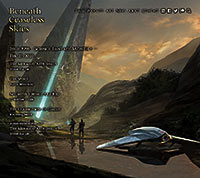Karen Burnham Reviews Short Fiction: BCS, Clarkesworld, Tor.com, Lightspeed, Kaleidotrope, and Giganotosaurus
 Beneath Ceaseless Skies 2/27/20, 3/12/20
Beneath Ceaseless Skies 2/27/20, 3/12/20
Clarkesworld 3/20
Tor.com 2/26/20
Lightspeed 3/20
Kaleidotrope Winter 2020
Giganotosaurus 3/20
Beneath Ceaseless Skies‘s “Science Fantasy Month” – now in its fifth iteration – is one of my favorite biennial events in speculative fiction. Issues #298 and 299, both doubles, are given over to stories that blend science fiction and fantasy in whatever proportions the authors care to offer, and the results are universally intriguing. Last time around, Yoon Ha Lee’s “The Starship and the Temple Cat” stood out, making the Sturgeon and Locus Awards lists. This year I expect his “The Mermaid Astronaut” to get even more attention. Essarala is a mermaid who yearns for the stars. When interstellar traders come to visit, she sees an opportunity to follow her dreams. Her sister helps her find the deep witch under the sea who grants her the legs she’ll need to go aboard the decidedly non-amphibious starship. She joins the crew and has amazing adventures, thinking that she’ll have plenty of time to go home someday. Those readers familiar with the time dilation effect of relativity will understand that there’s a ticking clock that she’s unaware of…. In the end this is a great story that takes problematic source material and makes it into something truly lovely and humane.
“My Sister’s Wings Are Red” by Christine Tyler is another standout. The worldbuilding is bizarre, in a good way, where humans are just one stage of the life cycle of an insectoid race structured like a bee colony. Olive is a worker, rescued from pure drudgery by a cook who considers herself a mother. Olive spends her days making food for the royal court and enviously romanticizing her vision of the life the Queen must live. When it becomes apparent that one of her sisters will come out of the pupa with red wings, making her the next Queen, Olive is beside herself with jealousy. Given a series of encounters with the Court, however, she realizes what the Queen’s reality is like, and “romantic” is just about the opposite of the truth. I’m leaving out a lot of delightful details for you to discover for yourself. Olive isn’t my favorite protagonist, bouncing from one strongly held, wrong-headed opinion to the next almost minute by minute, but overall this is one of those wildly imaginative stories that can make you think about the world very differently.
The second special issue leads off with “The Sniper and I” by Rich Larson, a creepy story of an observer/spotter sent to work with a cybernetically modified sniper, a human who has been totally integrated with their weapon. Legends about the sniper flow around the urban battlefield, and eventually the narrator has to ask “Can you still differentiate between yourself and your weapon?” This is a detailed portrait of a posthuman psychological breakdown. In “Truth as a Prize” by R.Z. Held, Naomi has been trapped as a ghost in a game that ends with lethal consequences. She’s been waiting for an opportunity to help even one contestant survive to get the word out to others. When blood mage Dianthus comes, following in the footsteps of her granddaughter Althea, Naomi might finally have her chance. While the story doesn’t give the reader much sense of what the world outside of the Game must be like, the story of outwitting an omnipotent Game is a classic one, and this is well done. Laine Bell gives us the story of an alien society told from their point of view in “Song of the Water Bear“. Cel is a tardigrade-like creature awakening from the suspended animation they experience when their environment dries up. She takes over leadership assuming they’re in for a normal season of stocking up supplies and caring for eggs, when suddenly a new threat appears to drive them from their home. Tardigrades are endlessly fascinating, and this story does a great job of imagining a world from their perspective.
Finally, “Only the Messenger” by Emily C. Skaftun gives us Astrill, a squid-like engineer on an interstellar ship in a universe where reincarnation is completely real and one can remember past lives. Astrill is heartbroken that zir partner has broken up with them remotely, but that private angst is put aside when there’s a knock on the airlock door. In floats Ennesta, who appears to be a cat-like alien creature that no one believes has just randomly bumped into their ship in the vastness of space with no harm done. The mystery of Ennesta’s existence seems to be bound up with the very proprietary secrets of the InstaComm system used by many ships for FTL communications, which cannot be investigated, on pain of mind wipe and worse. That plot would be interesting enough on its own; then Skaftun adds an ethical dilemma and a ticking clock to rocket the story to its conclusion. I loved the eclectic crew of aliens and Astrill’s distinct perspective on things throughout.
March’s Clarkesworld starts out with a story from Derek Künsken set in China. “Time Reveals the Heart” imagines a time-traveling archaeologist with a deeply alcoholic mother. He’s starting to form more attachment to the virtual version of her that he’s summoned up, but at the same time he’s becoming more addicted to the psychedelic drugs that enable his jaunts to the past. While on a mission to retrieve a modern artefact lost by a fellow researcher, he realizes just how close to the edge he’s living and he has to make a choice about how to proceed. The strongest part of the story is the description of the time travel process, told in vivid technicolor. Clarkesworld regular D.A. Xiaolin Spires contributes a story about a frustrated barista whose physicist friend points the way to brewing the perfect cup of coffee using a miniaturized particle accelerator to smash the beans. Hijinks ensue as they work to get their hands on the technology that will enable her dream in “Coffee Boom: Decoctions, Micronized“.
M.L. Clark‘s “Leave-Taking” continues in the same setting as last year’s excellent “To Catch All Sorts of Flying Things“. On this world, four very different species are extracting the planet’s resources under the mediation of a bunch of arachnid bio-computers. In this story Leni is writing to their partner Silv as their relationship goes through on-again/off-again cycles; at the same time Leni makes first contact with the fungal Fera who try to understand Leni and end up making a copy of the human, a thing both disturbing and pathetic. Character growth ensues. This world is so storyable that it is no surprise to me that Clark is working on a novel in this setting, and I’ll look forward to seeing it. Another follow-on story is “Grayer than Lead, Heavier than Steel” by Yukimi Ogawa, continuing in the world from last year’s “Ripen“. This is a world heavily segregated between the colorful and patterned people and the color- and pattern-less. We follow a pair of colorless craftspeople who can make patterns to repair many items – and affect people as well. Here they’re hired by an android to help a rich master who has fallen into addiction. After fulfilling that commission, the android swipes some of their materials and mis-applies them, causing another mess for the craftspeople to clean up. I’ve never felt like I fully grasp the underpinnings of the worldbuilding in these stories, but there is an undeniable humanity and intensity to them.
Next up is the heart-wrenching story “The Amusement Dark” by Mike Buckley. Cal is a human on an explorer ship run by AIs after humans decisively lost an interstellar war and the AIs became our new overlords. Cal lost his wife on a mission and when we meet him, he is plagued by a geezix, an artificial construct pretending to be his daughter – no wonder he is retreating into drink whenever possible. On another mission he discovers a world that looks like a run-down amusement park complete with roller coasters; underground he also discovers human “survivors,” kept obscenely alive by the AIs. In rescuing them there is a ray of hope that he might be able to create a meaningful future for himself.
The last story of the issue is my favorite, “The Whale Fall at the End of the Universe” by Cameron Van Sant. Its title is on the nose: in a universe entropically running down, where energy is scarce, Tristan drifts for untold eons between being able to awaken in the presence of enough light or energy. When they happen upon the corpse of an interstellar behemoth, Tristan settles in for a long stay. They meet another being, probably of a closely related species, to bond with, and have to deal with the other scavengers hanging around the remains. Eventually there’s nothing left to the bones of the creature, and they have to make their way out into the void again, quite poignantly.
Looking all the way back to February, one Tor.comstory I missed was the excellent “Sinew and Steel and What They Told” by Carrie Vaughn. Graff survived a catastrophe on a scouting mission that should have killed any purely organic being. His lover is the ship’s doctor, who now knows that Graff has been hiding a very deep secret for a very long time. The doctor and the ship’s captain have to decide what to do with Graff, and we get the whole story from Graff’s POV as he lies there hoping that they won’t kill or abandon him. Graff’s narration is sweetly vulnerable as he thinks through his predicament and the circumstances that brought him to this pass.
In March Lightspeed leads its science fiction section with “Giant Steps” by Russell Nichols. A black astrophysicist leaves her boyfriend and small child behind to go on a solo mission to Saturn’s moon Titan after something that looks like giant footprints are observed here. I had trouble buying into the idea that someone would be officially sent across the Solar System alone, but the story delves deep into Dr. Jenkin’s background, both with her grandmother and her boyfriend, and into the resonances that John Coltrane’s music has with some science fiction. It’s a fascinating intersection of SF and culture. “Love and Marriage in the Hexasun Lands” by Tahmeed Shafiq also blends genre with culture and myth on the fantasy side of the magazine. Adhamrya is a mortal king and married to the goddess of love, Schyan. Strife breaks out for his kingdom when her brother the god of war discovers his dalliance with Varabhata, a neighboring queen. The wife and the lover have an opportunity to meet, which leads to a very interesting resolution.
In the Winter 2020 issue Kaleidotrope showcases a broad range of emotional registers across its stories. It starts with “Tasting Menu” by Kristen Koopman, where a woman hoping for a job at her friends’ restaurant (which has become very famous), goes through a tasting course where every bite is a revelation both to the tastebuds and the emotions – and of course there’s a hint of something more sinister at play. “Miss Karami’s Academy for Time-Warping Ladies” by Kat Otis is a boarding-school romp where twin sisters get up to hijinks at their academy despite being separated for some time. In contrast, “Dissonance” by Kelly Washington is an intentionally disorienting story of a woman who is the sole survivor of a mission to an alien planet; after many years in the alien’s dubious care she is more than a little disturbed, especially after bearing a child.
My favorite story of the issue is “The Last Ship Out of Exville” by Phoebe Barton. Out in the outer Solar System, a group of misfits took over an abandoned space station that no one else wanted and made it their own. As a fascist society grows up on one of Jupiter’s moons, goons from that army eventually head in to commandeer the station. After one last concert broadcast to the whole system, our heroes evacuate and watch the military move in. But they’ve left one last surprise for the invaders, a fantastic trap that I really appreciated. This very short piece got me easily rooting for the good guys.
Giganotosaurus‘s March story is “The Air in My House Tastes Like Sugar” by ZZ Claybourne. It takes the Hansel and Gretel story as its starting point, but goes in very different directions. Amnandi is the daughter of Unina (mother) Khumalo, who is teaching her how to be a witch. Unfortunately, perfectly innocent uses of magic can look sinister to one’s mundane children friends, especially in a land suspicious of magic. Moving frequently, they eventually make friends with a family who tells them about some things going wrong in the land. Unina realizes that she can likely help and, with Amnandi’s assistance, faces a malevolent spirit at the climax. There are many layers to this story, especially with the Khumalos’ clearly African-derived magic (they come from a land here called “Afrela”) and how it appears in a European context (here called “Eurola”).
Recommended Stories
“The Last Ship Out of Exville”, Phoebe Barton (Kaleidotrope Winter ’20)
“The Mermaid Astronaut”, Yoon Ha Lee (Beneath Ceaseless Skies 2/27/20)
“Only the Messenger”, Emily C. Skaftun (Beneath Ceaseless Skies 3/12/20)
“My Sister’s Wings Are Red”, Christine Tyler (Beneath Ceaseless Skies 2/27/20)
“The Whale Fall at the End of the Universe”, Cameron Van Sant (Clarkesworld 3/20)
“Sinew and Steel and What They Told”, Carrie Vaughn (Tor.com 2/26/20)
Karen Burnham is an electromagnetics engineer by way of vocation, and a book reviewer/critic by way of avocation. She has worked on NASA projects including the Dream Chaser spacecraft and currently works in the automotive industry in Michigan. She has reviewed for venues such as Locus Magazine, NYRSF, Strange Horizons, SFSignal.com, and Cascadia Subduction Zone. She has produced podcasts for Locusmag.com and SFSignal.com, especially SF Crossing the Gulf with Karen Lord. Her book on Greg Egan came out from University of Illinois Press in 2014, and she has twice been nominated in the Best Non Fiction category of the British SF Awards.
This review and more like it in the May 2020 issue of Locus.
 While you are here, please take a moment to support Locus with a one-time or recurring donation. We rely on reader donations to keep the magazine and site going, and would like to keep the site paywall free, but WE NEED YOUR FINANCIAL SUPPORT to continue quality coverage of the science fiction and fantasy field.
While you are here, please take a moment to support Locus with a one-time or recurring donation. We rely on reader donations to keep the magazine and site going, and would like to keep the site paywall free, but WE NEED YOUR FINANCIAL SUPPORT to continue quality coverage of the science fiction and fantasy field.






